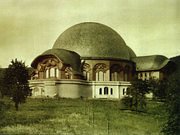I was lead to Steiner partly through the group of Seven who were for the most part THEOSOPHISTS. Steiner founded the theosophy society. I came to this area of study originally in University while studying the connection between magic and art.
This dude is interesting because it seems like he had his hand in many influential pots of the period.
Steiner characterized history as essentially shaped by changes formed through a progressive development of human consciousness. The activity of individualised human thinking was seen as a relatively recent advance which led to the dramatic developments of the Renaissance and the Industrial Revolution. In his epistemological works, he advocated the Goethean view that thinking itself is a perceptive instrument for ideas, just as the eye is a perceptive instrument for light.
He characterized his system of Anthroposophy as follows:
"Anthroposophy is a path of knowledge, to guide the spiritual in the human being to the spiritual in the universe... Anthroposophists are those who experience, as an essential need of life, certain questions on the nature of the human being and the universe, just as one experiences hunger and thirst."
Steiner developed an organic style of architecture for the design and construction of some seventeen buildings. The most significant of these are the first and second Goetheanums. These two structures, both built in Dornach, Switzerland intended to house a University for Spiritual Science.
Wednesday, September 28, 2005
Goetheanum
Subscribe to:
Post Comments (Atom)

1 comment:
Steiner also influecend the Inkling. An important group for anyone studying medieval literature. C.S. Lewis, J.R.R. Tolkein, and many others were influecned by Steiner through Owen Barfield another memeber of the Inklings who as a self proclaimed theosophist brought an important philosophical perspective to the works these great authors would create.
Post a Comment